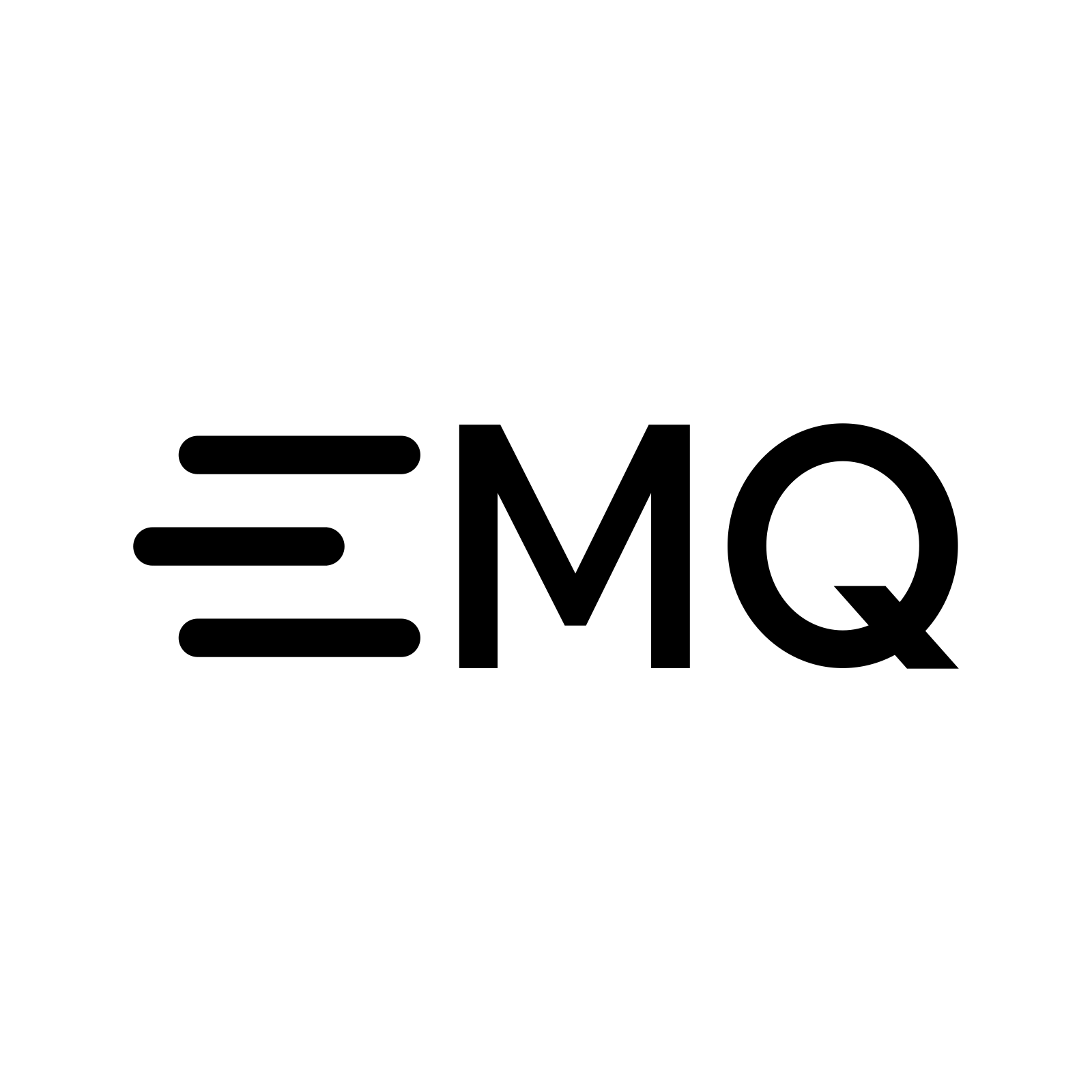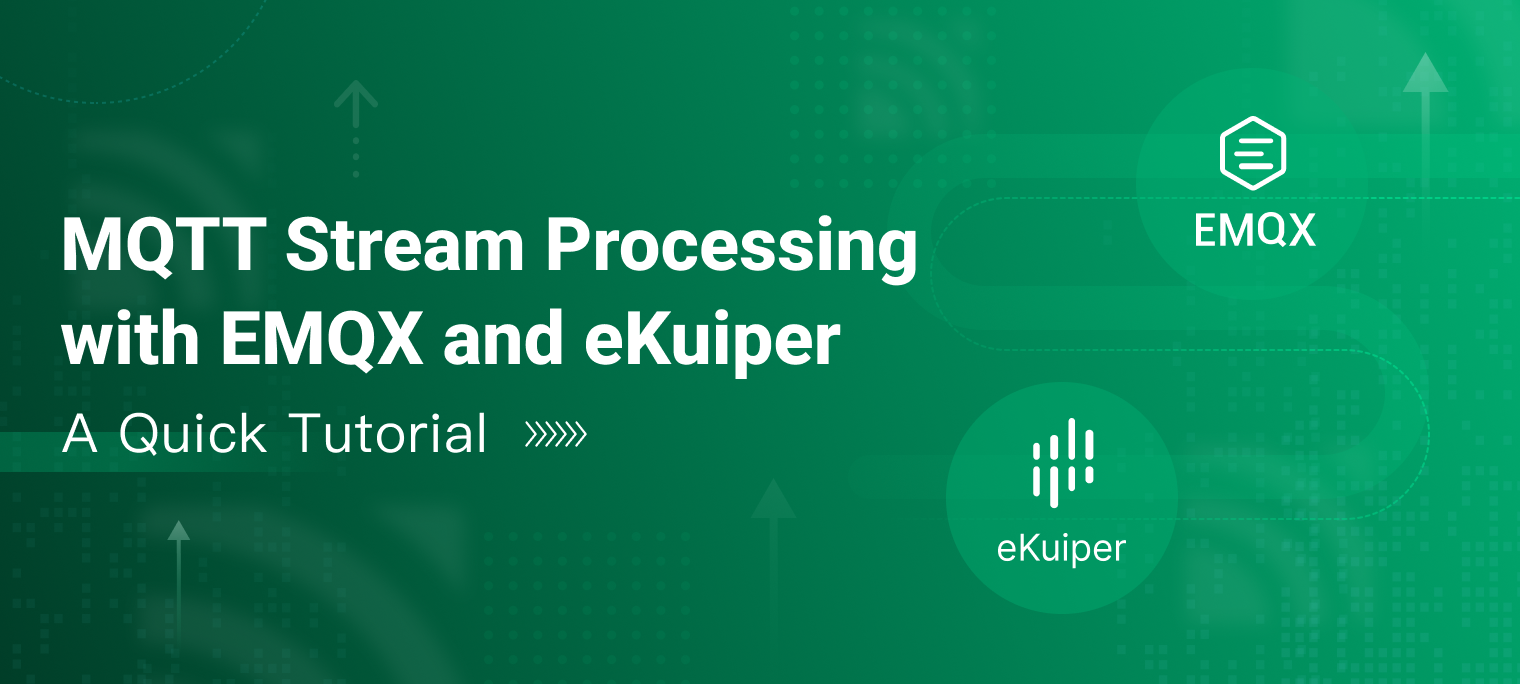MQTT Stream Processing with EMQX and eKuiper: A Quick Tutorial
 EMQX
EMQX
Introduction
MQTT protocol is a lightweight messaging protocol that is ideal for IoT applications. It is designed to be simple, open, and easy to implement, making it a popular choice for IoT applications. MQTT data are ingested continuously and in real-time and thus are suitable to be processed by stream processing engines.
As a large-scale distributed MQTT broker for IoT, EMQX can efficiently and reliably connect to massive IoT devices, and process and distribute messages and event flow data in real-time. eKuiper is an open-source stream processing engine that can filter, transform, and aggregate streaming data.
This article will demonstrate using eKuiper to stream process MQTT data from EMQX in real-time.

Scenario Description
Suppose we have an MQTT topic demo/sensor that collects temperature and humidity data in EMQX. We want to use eKuiper to subscribe to the topic, process and analyze the data with streaming technology and trigger actions to users' HTTP service or save the result to external storage.
EMQX
Thanks to EMQX’s standard MQTT protocol support, eKuiper can connect to any version of EMQX. Here, we use the free public MQTT Broker provided by EMQX Cloud for testing:
| Cluster | Address of Cluster | Listening Port |
| emqx1 | broker.emqx.io | 1883 |
eKuiper
We can install eKuiper on the edge or cloud side. We can use Docker to quickly install it.
docker run -p 9081:9081 -d --name kuiper -e MQTT_SOURCE__DEFAULT__SERVER=tcp://broker.emqx.io:1883 lfedge/ekuiper:1.10.0
By this command, we can pull eKuiper 1.10.0 version docker image and start running it. We set the REST API port to 9081, and we will use this API to manage eKuiper in this tutorial. We also set the default MQTT broker address to EMQX Cloud cluster by the environment variable.
For other installation methods, please check the installation guide to install eKuiper.
EMQX ECP (EMQX Edge-to-Cloud Platform) is an advanced MQTT platform designed for edge-cloud collaboration. It provides professional web UI to manage eKuiper. You can also use ECP to manage eKuiper in this tutorial. Please check the ECP documentation for more details.
Configure eKuiper to Subscribe to MQTT Data Stream
The MQTT data are usually unbounded and continuous streaming data. In eKuiper, there is a concept called stream, which is a model for such kind of data. Before processing the MQTT data, we need to create a stream to describe the data.
Let's use eKuiper REST API to create a stream:
POST http://127.0.0.1:9081/streams
Content-Type: application/json
{
"sql": "CREATE STREAM demoMqttStream (temperature FLOAT, humidity FLOAT) WITH (TYPE=\"mqtt\", DATASOURCE=\"demo/sensor\", FORMAT=\"json\", SHARED=\"true\")"
}
Send out the above request with any HTTP clients such as Postman. We can create a stream named demoMqttStream with MQTT type data source. The datasource property is demo/sensor, which means subscribing to this topic in MQTT. The data format is JSON. The SHARED option means the stream is shared by all the rules.
Note:
The default MQTT broker address is set to
tcp://broker.emqx.io:1883when we run the eKuiper docker container. If you use another MQTT broker, change that address to your broker address when installing.If you want to change the MQTT broker address and any other MQTT connection parameter like authentication, try to change the setting on
data/mqtt_souce.yamlfile.You can subscribe to multiple topics by using the
+and#wildcard in thedatasourceproperty. For example,demo/+means to subscribe to all the topics starting withdemo/.demo/#means to subscribe to all the topics starting withdemo/and all the subtopics underdemo/.
Stream Processing MQTT data
In eKuiper, we define rules for stream processing workflows. A rule is a SQL statement that defines how to process the data and the actions to perform after processing. Besides continuous data processing, stream processing engines like eKuiper also support stateful processing. We will demonstrate two examples of stream processing and stateful processing.
Stateful Alert Rule
The first stream processing example is to detect the temperature and humidity data and trigger an alert when the temperature has increased more than 0.5 or the humidity has increased more than 1. This requires the processing engine to maintain the state of the previous data and compare it with the current data.
Suppose we have an HTTP webhook that can receive the alert data with the URL http://yourhost/alert. We can create a rule with the following HTTP request.
###
POST http://{{host}}/rules
Content-Type: application/json
{
"id": "rule1",
"sql": "SELECT temperature, humidity FROM demoMqttStream WHERE temperature - LAG(temperature) > 0.5 OR humidity - LAG(humidity) > 1",
"actions": [{
"rest": {
"url": "http://yourhost/alert",
"method": "post",
"sendSingle": true
}
}]
}
We create a rule named rule1 with the SQL statement below:
SELECT temperature, humidity
FROM demoMqttStream
WHERE
temperature - LAG(temperature) > 0.5
OR humidity - LAG(humidity) > 1
This SQL query will select the temperature and humidity data from the demoMqttStream when their change meets our criteria. Whereas the LAG function is used to get the previous data.
The actions property defines the actions to perform after the rule is triggered. Here, we use the rest action to send the data to the http://yourhost/alert endpoint. The sent data is the JSON format of the data selected by the SQL query. Thus, the data sent to the endpoint will be like this:
{
"temperature": 25.5,
"humidity": 60.5
}
Test the Rule
We can use MQTTX or any other MQTT client to publish MQTT data to the demo/sensor topic. Those data will be processed by the rule. For example, we publish the following data on the topic:
{"temperature": 25.5, "humidity": 60.5}
{"temperature": 26.1, "humidity": 62}
{"temperature": 25.9, "humidity": 62.1}
{"temperature": 26.5, "humidity": 62.3}
We will receive in our HTTP alert services the following data:
{"temperature": 26.1, "humidity": 62}
{"temperature": 26.5, "humidity": 62.3}
This is because only for the 2nd and 4th messages, the temperature has increased more than 0.5 or the humidity has increased more than 1.
If you encounter any problems running the rule, please refer to How to Debug Rules | eKuiper Documentation for help.
Time Window Aggregation Rule
The second example is to calculate the average temperature and humidity for each minute and send it back to EMQX. This involves a classical stream processing concept called time window. We can create a rule with the following HTTP request.
###
POST http://{{host}}/rules
Content-Type: application/json
{
"id": "rule2",
"sql": "SELECT
trunc(avg(temperature), 2) as avg_temperature, trunc(avg(humidity), 2) as avg_humidity, window_end() as ts FROM demoMqttStream GROUP BY TumblingWindow(mi, 1)",
"actions": [{
"mqtt": {
"server": "tcp://broker.emqx.io:1883",
"topic": "result/aggregation",
"sendSingle": true
}
}]
}
We create a rule named rule2 with the SQL statement below:
SELECT
trunc(avg(temperature), 2) as avg_temperature,
trunc(avg(humidity), 2) as avg_humidity,
window_end() as ts
FROM demoMqttStream
GROUP BY TumblingWindow(mi, 1)
This SQL query will select the average temperature and humidity data for each minute. The time window is defined in the GROUP BY clause with TumblingWindow. This window type splits MQTT data into fixed-length windows. In the SELECT clause, we use the aggregate function avg to calculate the average values for both temperature and humidity in the time window. The window_end() function is used to get the end time of the time window so that we'll know when these average values are calculated. The trunc function is used to round the average value to 2 decimal places.
The actions property defines the actions to perform after the rule is triggered. Here, we use the mqtt action to send the data to the result/aggregation topic in EMQX. The sent data is the JSON format of the data selected by the SQL query. Thus, the data sent to the topic will be like this:
{
"avg_temperature": 25.5,
"avg_humidity": 60.5,
"ts": 1621419600000
}
Test the Rule
Again, we can use MQTTX or any other MQTT client to publish MQTT data to the demo/sensor topic. Those data will be processed by the rule. For example, we publish the following data to the topic with a 30 seconds interval, and the two minutes data is like this:
{"temperature": 25.5, "humidity": 60.5}
{"temperature": 26.1, "humidity": 62}
{"temperature": 25.9, "humidity": 62.1}
{"temperature": 26.5, "humidity": 62.3}
We will receive in our HTTP alert services the following data:
{"avg_temperature": 25.8, "avg_humidity": 61.25, "ts": 1621419600000}
{"avg_temperature": 26.2, "avg_humidity": 62.2, "ts": 1621419660000}
We have sent out 2 minutes' data so that we got two average values for each minute.
Summary
In this tutorial, we have learned how to use eKuiper to process MQTT data. Now you can:
Subscribe to EMQX MQTT broker to get MQTT data
Create rules to process MQTT data
Send the processed data back to the EMQX broker
We show two examples to demonstrate the streaming capability of eKuiper against MQTT data. eKuiper has a powerful streaming capability that can be leveraged against a wide range of streaming data sources. Welcome to explore eKuiper's capabilities to build efficient data processing pipelines against the MQTT data in real time.
Originally published at www.emqx.com
Subscribe to my newsletter
Read articles from EMQX directly inside your inbox. Subscribe to the newsletter, and don't miss out.
Written by

EMQX
EMQX
EMQX is the world's most scalable open-source MQTT broker with a high performance that connects 100M+ IoT devices in 1 cluster, while maintaining 1M message per second throughput and sub-millisecond latency.